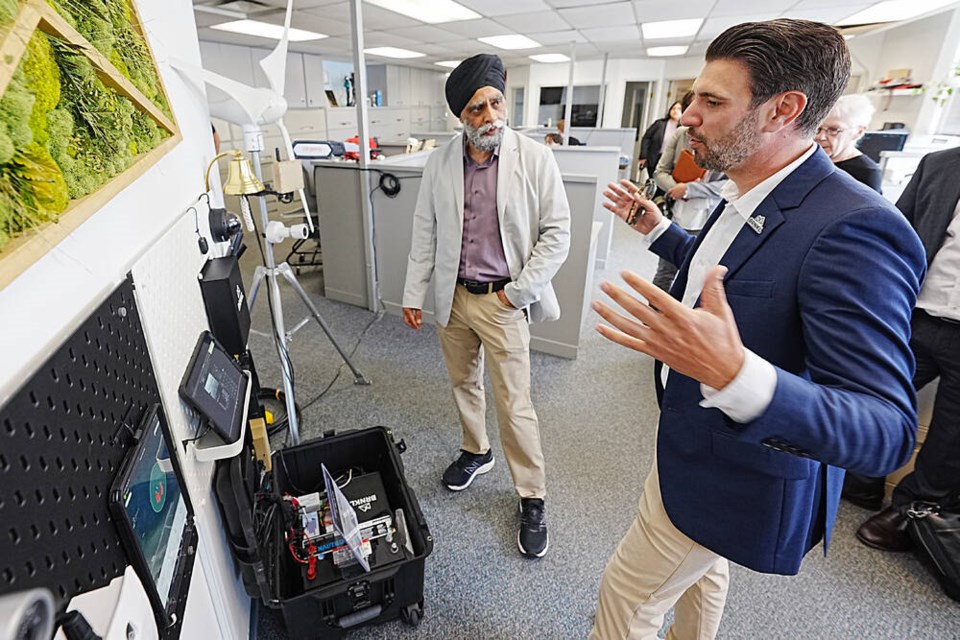Brandon Wright runs a company out of Oak Bay Marina that designs remote security and monitoring systems for vessels ranging from small sailing and pleasure craft to fisheries and police boats and Canadian warships.
Barnacle Systems Inc. produces the software and hardware to monitor location, cabin status and engine conditions. In more detailed applications, the software can monitor the vital signs of the ship’s operators.
“We’re installed on the RCMP boats, DFO fisheries, search and rescue vessels and big in special forces and the Royal Canadian Navy,” said Wright, who employs 15 people and sells the systems into 40 countries. “We can pull in engine and camera data, environmental data. It gets the whole health of the boat.
“We can also tie in biometric data [through cameras and sensors] so we can understand the stress of the people on the boat that can measure skin temperature and moisture, so someone like special forces can understand during events how stressed they may actually be.”
Wright, a UVic grad, started developing surveillance systems after working for the U.S. Central Intelligence Agency and U.S. Air Force.
Barnacle Systems is an example of the region’s deep talent pool and massive potential in the so-called Blue Economy, where research and development is spawning innovation by startup companies in transportation, food, environmental protection and other sectors associated with the ocean.
On Tuesday, the South Island Prosperity Partnership, received $3 million in funding from Ottawa’s Pacific Economic Development Agency to support the ocean and marine technology sectors as well as First Nations groups who are doing ocean monitoring and conservation.
Minister Harjit Sajjan announced a total of $8.1 million in funds that will also support $1.9 million for two projects at the University of Victoria and $820,000 to the Association of British Columbia Marine Industries.
Emilie de Rosenroll, chief executive of the South Island Prosperity Partnership, said the funds will support the development of a marine innovation network and training hub through COAST, the blue economy arm of SIPP dedicated to expanding B.C.’s rapidly growing marine technology sectors. The funding will also expand Indigenous entrepreneurship and the exploration of economic opportunities involving SIPP’s Indigenous-led arm, the Indigenous Prosperity Centre.
SIPP, founded in 2016, has about 70 member organizations including municipal and First Nations governments, industry associations and post secondary institutions.
COAST has 130 members across B.C., where de Rosenroll said there has been a 70% increase in startup companies involved in ocean-related work.
“It’s sort of like a sleeping giant awakes,” she said. “We’re starting with a virtual training hub where we’re going to pool micro-credentials so there are ways for people to rapidly upscale and transition from one job to another without having to go back and take a four-year degree. The idea is to pool programs together and develop customized programming.
Jason Goldsworthy, executive director of COAST, said ocean and marine industries are a vital component to the Canadian economy. “There are an increasing number of innovators and entrepreneurs working to better our use and interactions with the ocean,” he said. “We will support these enterprises on their path to market by finding solutions to key industry challenges.”
Those include attracting talent, capital and partnerships, identifying and providing training opportunities and connecting private and public organizations.
De Rosenroll said the ocean industry economy is worth billions of dollars and will grow into trillions in the decade ahead. “We need to start thinking about how we can more sustainably use the assets of the ocean for transportation, food, recreation, and we need innovators to do that.”
Christina Clarke, executive director of the Indigenous Prosperity Centre, said South Island First Nations are already taking roles in the blue economy by using vessels to respond to oil spills, fisheries research and enforcement and monitoring species and environmental conditions. She said they will work with COAST to connect Indigenous marine stewards to training, investments and partnerships.
“We want to see now where Indigenous people can leverage the talent and the people and the assets they have into revenue generation so they keep their monitoring activities going,” said Clarke.
One of the areas is commercial kelp farming and how First Nations could be involved. “We don’t want kelp farms everywhere at the expense of other species and the Nations are very sensitive to that. They are very aware of the species in their territories and what species they want to bring back, so it makes sense to include Indigenous people in making decisions on where kelp forests could be.”
Another example for economic opportunities are the eradication of the invasive green crab, which threatens native Dungeness crab and and young salmon. Clarke said connecting First Nations who are involved in catching green crab with companies that could process them as food and fertilizers is an another example of a potential partnership.
Meanwhile, UVic’s Proteomics Centre received $1.3 million in funding to purchase and install a flex mass spectrometer to be used to support drug development, cancer research and other medicines. UVic also received funding to do assessments for wind and tidal energy projects that would replace diesel generators on Haida Gwaii.
>>> To comment on this article, write a letter to the editor: [email protected]



